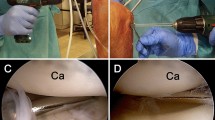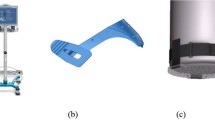Abstract
Purpose
Slippage of the wires over the opposite cortex from the endosteal side is frequent and can lead to insufficient stability. This in vitro biomechanical study was planned to investigate the angle of wire insertion that leads to trans cortex perforation.
Methods
Long bones of sheep were cut longitudinally into two pieces and half bones were stabilised on a frame. Three orthopaedic surgeons performed the experiment using ten wires of four different diameters at two different drilling speeds. Each wire was introduced from the endosteal side at angles starting at 30° in 5° increments until perforation. When perforation was achieved, the angle was recorded. To determinate the critical angle of perforation, receiver operating characteristic (ROC) curve analyses was performed. Two-way factorial analysis of variance (ANOVA) and Kruskal–Wallis tests were used for statistical comparisons.
Results
Kirschner-wire insertion angles of ≥45° provided perforation with a percentage of 83.9 %. Wire diameter, drilling speed and surgeon variables had no effect on perforation angles (p > 0.05).
Conclusion
If preoperative evaluation of fractures to be fixed by K wires reveals the need for oblique wire insertion angle <45°, a standard trocar-tip K wire application would lead to slippage of the wire tip on the endosteal surface of the opposite cortex. According to this study, the operative plan should be changed if such obliquity of the K wire is mandatory during bicortical applications.




Similar content being viewed by others
References
Vatansever A, Piskin A, Kayalar M, Bal E, Ada S (2007) The effect of dorsal cortical comminution on radiographic results of unstable distal radius fractures treated with closed reduction and K-wire fixation. Acta Orthop Traumatol Turc 41:202–206
Szyluk K, Jasinski A, Koczy B, Widuchowski W, Widuchowski J (2007) Results of operative treatment of unstable distal radius fractures using percutaneous K wire fixation. Ortop Traumatol Rehabil 9:511–519
Gurkan V, Orhun H, Akca O, Ercan T, Ozel S (2008) Treatment of pediatric displaced supracondylar humerus fractures by fixation with two cross K-wires following reduction achieved after cutting the triceps muscle in a reverse V-shape. Acta Orthop Traumatol Turc 42:154–160
Zionts LE, Woodson CJ, Manjra N, Zalavras C (2009) Time of return of elbow motion after percutaneous pinning of pediatric supracondylar humerus fractures. Clin Orthop Relat Res 467:2007–2010
Parmaksizoglu AS, Ozkaya U, Bilgili F, Sayin E, Kabukcuoglu Y (2009) Closed reduction of the pediatric supracondylar humerus fractures: the "joystick" method. Arch Orthop Trauma Surg 129:1225–1231
Magovern B, Ramsey ML (2008) Percutaneous fixation of proximal humerus fractures. Orthop Clin North Am 39:405–416
Namba RS, Kabo JM, Meals RA (1987) Biomechanical effects of point configuration in Kirschner-wire fixation. Clin Orthop Relat Res 214:19–22
Graebe A, Tsenter M, Kabo JM, Meals RA (1992) Biomechanical effects of a new point configuration and a modified cross-sectional configuration in Kirschner-wire fixation. Clin Orthop Relat Res 283:292–295
Sankar WN, Hebela NM, Skaggs DL, Flynn JM (2007) Loss of pin fixation in displaced supracondylar humeral fractures in children: causes and prevention. J Bone Joint Surg Am 89:713–717
Habernek H, Weinstabl R, Fialka C, Schmid L (1994) Unstable distal radius fractures treated by modified Kirschner wire pinning: anatomic considerations, technique, and results. J Trauma 36:83–88
Strohm PC, Muller CA, Boll T, Pfister U (2004) Two procedures for Kirschner wire osteosynthesis of distal radial fractures. A randomized trial. J Bone Joint Surg Am 86:2621–2628
Zionts LE, McKellop HA, Hathaway R (1994) Torsional strength of pin configurations used to fix supracondylar fractures of the humerus in children. J Bone Joint Surg Am 76:253–256
Topping RE, Blanco JS, Davis TJ (1995) Clinical evaluation of crossed-pin versus lateral-pin fixation in displaced supracondylar humerus fractures. J Pediatr Orthop 15:435–439
Mow VC, Flatow EL, Ateshian GA (2000) Mechanical properties of materials. In: Buckwalter JA, Einhorn TA, Simon SR (eds) Orthopaedic Basic Science, 2nd edn. AAOS, Illinois, pp 133–180
Zohman GL, Tsenter M, Kabo JM, Meals RA (1992) Biomechanical comparisons of unidirectional and bidirectional Kirschner-wire insertion. Clin Orthop Relat Res 284:299–302
Acknowledgement
K wires used in this study were donated by Ortopro, Izmir, Turkiye. Sheep bones were supplied from Dervisoglu butcher (Mersin, Turkiye). Special thanks to Helfer Makina (Mersin, Turkiye) employees for their technical support.
Conflict of interest statement
All authors declare that they have no conflict of interest.
Author information
Authors and Affiliations
Corresponding author
Rights and permissions
About this article
Cite this article
Colak, M., Gurer, B., Sungur, M.A. et al. Forty-five-degree or higher insertion angles are required to penetrate the opposite cortex in bicortical applications of Kirschner wires: an in vitro study on sheep bones. International Orthopaedics (SICOT) 36, 857–862 (2012). https://doi.org/10.1007/s00264-011-1264-0
Received:
Accepted:
Published:
Issue Date:
DOI: https://doi.org/10.1007/s00264-011-1264-0




